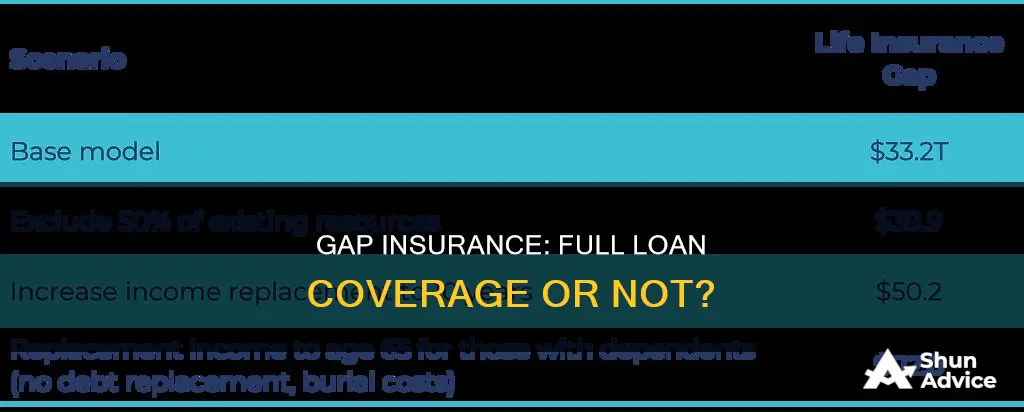
Gap insurance is an optional auto insurance coverage that applies if your car is stolen or deemed a total loss. When your loan amount is more than your vehicle is worth, gap insurance coverage pays the difference. It is important to note that gap insurance does not cover the entire loan amount. It only covers the difference between the amount owed on the loan and the value of the vehicle. This means that if you owe more on the loan than the car is worth, you will still be responsible for paying off the remaining balance. Gap insurance also does not cover additional charges such as finance or mileage fees and late payment fees.
| Characteristics | Values |
|---|---|
| What is GAP insurance? | Optional auto insurance coverage that applies if your car is stolen or deemed a total loss. |
| When is it needed? | When the loan amount is more than the vehicle is worth. |
| What does GAP insurance cover? | GAP insurance covers the difference between the amount you owe on your auto loan and the amount the insurance company pays. |
| What does GAP insurance not cover? | Down payment for a new car, charges for credit insurance, carry-over balances from previous loans or leases, extended warranties, lease penalties for high mileage or excessive use, overdue payments and late fees on car loan or lease, security deposits, and car insurance deductible. |
| Who offers GAP insurance? | Dealers, insurance companies, and direct lenders. |
What You'll Learn

What does GAP insurance cover?
GAP insurance, or Guaranteed Asset Protection insurance, is an optional product that covers the difference between the amount you owe on your auto loan and the amount your insurance company pays out if your car is stolen or deemed a total loss. This type of insurance is useful if you owe more on your car loan than the car is actually worth. In this case, standard auto insurance will only pay out an amount up to the car's value, leaving you with a gap that you will have to pay out of pocket. GAP insurance covers this difference, protecting you from depreciation and ensuring that your loan is paid off.
For example, let's say you owe $25,000 on your car loan, but your car is only worth $20,000. If your car is stolen or totalled, your standard insurance will only pay out $20,000, leaving you with a $5,000 gap. With GAP insurance, this $5,000 difference would be covered, minus your deductible. This can provide significant financial relief and help you avoid being stuck with a loan for a car you can no longer use.
It's important to note that GAP insurance does not cover additional charges related to your loan, such as finance charges, excess mileage charges, late fees, or previous loan balances. It also does not cover repairs or damage to other people's vehicles or property. GAP insurance is specifically designed to cover the gap between the insurance payout and your loan balance in the event of a total loss of your vehicle.
The coverage provided by GAP insurance can vary by policy and provider, so it's essential to carefully review the terms and conditions before purchasing. Additionally, GAP insurance is optional, and whether you need it depends on your financial situation and the value of your vehicle. If you have enough savings to cover the potential gap, you may not need GAP insurance. However, if you are concerned about being able to afford the gap in the event of a total loss, GAP insurance can provide valuable peace of mind.
Fannie and Freddie: College Loan Options Explored
You may want to see also

When is GAP insurance useful?
GAP insurance, or Guaranteed Asset Protection insurance, is an optional add-on coverage that can help certain drivers cover the “gap” between the financed amount owed on their car and their car’s actual cash value (ACV). It is useful when your loan amount is more than your vehicle is worth, as GAP insurance coverage pays the difference. For example, if you owe $25,000 on your loan and your car is only worth $20,000, your GAP coverage covers the $5,000 gap, minus your deductible.
GAP insurance is useful when your car is stolen or deemed a total loss. In the event of theft or a covered accident that results in a total loss, GAP insurance will pay the difference between your car’s actual cash value and the amount you still owe on your loan or lease. This can be particularly useful if you have a high-interest loan or lease with a large outstanding balance.
GAP insurance can also be useful if you have a low down payment or a long loan term. If you put less than 20% down on your car or finance your loan for 60 months or more, the "gap" between what you owe and what your car is worth can be significant. In these cases, GAP insurance can provide valuable protection.
Additionally, GAP insurance can be useful if you are concerned about negative equity. If you owe more on your trade-in than it is worth, GAP insurance can help cover the negative equity and protect you from being “upside down” on your new loan.
It's important to note that GAP insurance does not cover additional charges related to your loan, such as finance charges, late fees, or extended warranties. It also does not cover damage to other people's vehicles, property, or injuries. Whether you need GAP insurance depends on your financial situation and the value of your vehicle. If you have enough money to cover the "gap" yourself, you may not need GAP insurance.
Funding Loans: Escrow Closing and What You Should Know
You may want to see also

How does GAP insurance work?
GAP insurance, or guaranteed asset protection, is an optional auto insurance coverage that applies if your car is stolen or deemed a total loss. It is designed to bridge the gap between the claim payout amount and the balance still due on your car loan when you owe more than your car is worth. In other words, it covers the difference between the amount you owe on your auto loan and the amount your insurance company pays out if your car is stolen or totaled.
For example, if you owe $25,000 on your loan and your car is only worth $20,000, your gap coverage covers the $5,000 gap, minus your deductible. It is important to note that gap insurance does not cover additional charges related to your loan, such as finance or excess mileage charges, credit insurance connected to the loan, extended warranties, lease penalties, overdue payments, or late fees. It also does not cover engine failure or other repairs, or damage to other people's vehicles or property, or injuries.
GAP insurance is typically necessary if you owe more on your vehicle than it is worth. In this case, a standard car insurance policy will only cover up to the vehicle's current market value, leaving you responsible for the remaining loan balance. GAP insurance ensures that you are not left owing money after a total loss or theft of your vehicle.
The cost of GAP insurance can be rolled into the loan amount, and it is often offered by dealers when purchasing or leasing a car. However, it is important to note that GAP insurance may not be necessary if you have enough money to absorb the difference between the insurance payout and the loan balance, or if you have sufficient comprehensive or collision coverage on your policy.
Freddie Mac: Understanding Loan Guarantees and Their Benefits
You may want to see also

What does GAP insurance not cover?
Gap insurance is an optional auto insurance coverage that applies if your car is stolen or deemed a total loss. It covers the difference between the amount paid out by your comprehensive or collision coverage and the balance left on your vehicle loan or lease. However, there are certain things that gap insurance does not cover.
Firstly, gap insurance does not cover additional charges related to your loan, such as finance or excess mileage charges. It also does not cover engine failure or other repairs, as it is only applicable in the event of a total loss. Gap insurance also does not cover other property or injuries resulting from an accident.
Additionally, gap insurance does not cover certain expenses such as down payments for a new car, charges for credit insurance connected to the loan, carry-over balances from previous loans or leases, extended warranties, lease penalties for high mileage or excessive use, overdue payments, late fees, or security deposits. It is important to note that gap insurance is not a replacement for comprehensive or collision coverage and must be purchased in addition to these coverages.
While gap insurance can provide valuable financial protection in the event of a total loss or theft of your vehicle, it is important to understand its limitations and exclusions. It is designed specifically to cover the "gap" between the value of your vehicle and the balance of your loan or lease, and it does not cover other related expenses or charges.
How Foreclosure and Loan Modification Are Related
You may want to see also

Where can I buy GAP insurance?
When buying a new car, you can purchase GAP insurance from the dealer or your auto insurance company. You can typically add gap coverage to an existing car insurance policy or a new policy, as long as your loan or lease hasn't been paid off. Buying gap insurance from an insurance company may be less expensive, and you won't pay interest on your coverage.
If you already have car insurance, you can check with your current insurer to determine how much it would cost to add gap coverage to your existing policy. Note that you need comprehensive and collision coverage in order to add gap coverage to a car insurance policy. Some insurance companies may only offer a limited amount of time to purchase coverage.
If you are looking to buy gap insurance from somewhere other than the dealer, you can try local credit unions. You can also try shopping around for standalone gap insurance, but be aware that some policies require you to have auto insurance with the provider offering the gap coverage.
Funds Joy: Offering Loans in NY?
You may want to see also
Frequently asked questions
Gap insurance is an optional auto insurance coverage that applies if your car is stolen or deemed a total loss. It helps bridge the gap between what you owe on your car loan and what your car is actually worth.
Gap insurance covers the difference between the amount you owe on your auto loan and the amount the insurance company pays if your car is stolen or totalled. It does not cover the entire loan, as it does not include additional charges such as finance or mileage fees, late fees, or the deductible.
Gap insurance does not cover additional charges related to your loan, such as finance or mileage fees, late fees, credit insurance, extended warranties, lease penalties, security deposits, or the deductible. It also does not cover engine failure or other repairs, and it only covers totalled cars, not damaged but repairable ones.







